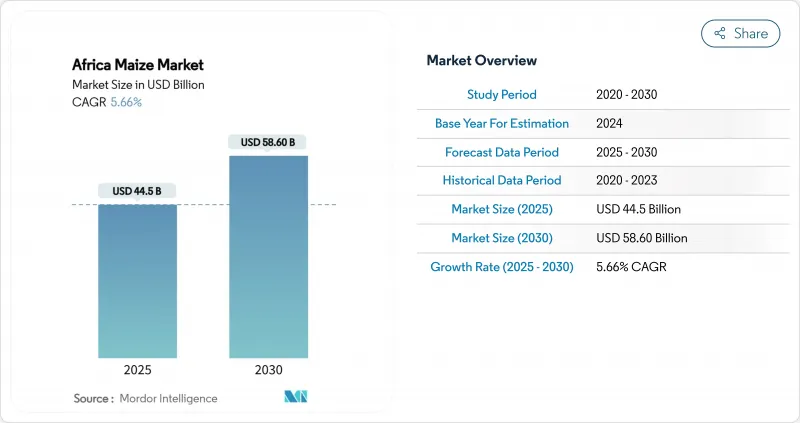PUBLISHER: Mordor Intelligence | PRODUCT CODE: 1852019

PUBLISHER: Mordor Intelligence | PRODUCT CODE: 1852019
Africa Maize - Market Share Analysis, Industry Trends & Statistics, Growth Forecasts (2025 - 2030)
The Africa maize market size is valued at USD 44.5 billion in 2025 and is forecast to reach USD 58.6 billion by 2030, at a CAGR of 5.66% during the forecast period.

Strong population growth, rapid urbanization, and expanding industrial applications sustain steady demand, while subsidy programs in key countries and climate-smart technologies boost supply capacity. Global commodity traders maintain a visible presence, rising domestic processors narrow historical dependence on imports, and create local value addition. Digital agronomy tools and conservation practices lift on-farm efficiency, although chronic infrastructure gaps and climate risks still cap yield potential. Overall, the African maize market benefits from synchronized demand pull and technology-driven supply stimulus, positioning the value chain for resilient long-term expansion.
Africa Maize Market Trends and Insights
Rising Food-Grain Demand from Population Growth
Africa's population is projected to hit 2.5 billion before 2050, raising structural demand for calorie-dense staples. Urban migration accelerates consumption of refined maize flour and ready-to-eat products, tightening supply chains that already feed major cities . Higher incomes in secondary cities shift diets toward processed foods that rely on maize as an affordable energy source. Policymakers nowadays prioritize strategic grain reserves to buffer shocks, further enlarging the baseline requirement. The African maize market consequently witnesses sustained volume growth and a broader price floor that supports farm investment even in volatile seasons.
Expanding Use in Compound Animal Feed
Commercial livestock and aquaculture operators replace imported inputs with local maize, creating parallel demand engines that compete with direct food use. Poultry integrators in South Africa illustrate how coordinated contracting guarantees growers a premium for feed-grade grain. Nigeria's aquaculture boom likewise values high-energy maize inclusions that improve feed conversion ratios. Feed millers pay quality premiums for specific starch and protein profiles, encouraging farmers to adopt hybrids tailored for livestock nutrition and deepening market sophistication.
Fall Armyworm and Other Pests
Annual losses of USD 10-13 billion stem from pest damage that cuts yields by up to 67% in hot-spot regions. Rapid resistance to legacy pesticides forces farmers to pivot toward integrated pest management, but fragmented extension systems hinder coordinated responses. Climate volatility enlarges pest windows and weakens natural predator cycles, compounding risk. Adoption of pest-resistant hybrids such as the genetically modified TELA series promises relief, but seed access and farmer acceptance remain hurdles.
Other drivers and restraints analyzed in the detailed report include:
- Government Subsidy and Input-Voucher Programs
- Carbon-Credit Incentives for Conservation Agriculture
- Post-Harvest Storage and Logistics Losses
For complete list of drivers and restraints, kindly check the Table Of Contents.
Segment Analysis
Africa Maize Market Report is Segmented by Geography (South Africa, Ethiopia, Nigeria, and More). The Report Includes Production Analysis (Volume), Consumption Analysis (Value and Volume), Export Analysis (Value and Volume), Import Analysis (Value and Volume), and Price Trend Analysis. The Market Forecasts are Provided in Terms of Value (USD) and Volume (Metric Tons).
List of Companies Covered in this Report:
- Market Overview
- Market Drivers
- Market Restraints
- Value / Supply-Chain Analysis
- Regulatory Landscape
- Technological Outlook
- PESTEL Analysis
- List of Key Stakeholders
Additional Benefits:
- The market estimate (ME) sheet in Excel format
- 3 months of analyst support
TABLE OF CONTENTS
1 Introduction
- 1.1 Study Assumptions and Market Definition
- 1.2 Scope of the Study
2 Research Methodology
3 Executive Summary
4 Market Landscape
- 4.1 Market Overview
- 4.2 Market Drivers
- 4.2.1 Rising food-grain demand from population growth
- 4.2.2 Expanding use in compound animal feed
- 4.2.3 Government subsidy and input-voucher programs
- 4.2.4 Growth of starch-based biomaterials and bioplastics
- 4.2.5 Digital agronomy tools boosting on-farm yields
- 4.2.6 Carbon-credit incentives for conservation agriculture
- 4.3 Market Restraints
- 4.3.1 Fall Armyworm and other pests
- 4.3.2 Post-harvest storage and logistics losses
- 4.3.3 Soil nutrient depletion and micronutrient deficiency
- 4.3.4 Fertilizer-price volatility for smallholders
- 4.4 Value / Supply-Chain Analysis
- 4.5 Regulatory Landscape
- 4.6 Technological Outlook
- 4.7 PESTEL Analysis
5 Market Size and Growth Forecasts (Value and Volume)
- 5.1 By Geography (Production Analysis by Volume, Consumption Analysis by Volume and Value, Import Analysis by Volume and Value, Export Analysis by Volume and Value, and Price Trend Analysis)
- 5.1.1 Nigeria
- 5.1.2 South Africa
- 5.1.3 Ethiopia
- 5.1.4 Tanzania
- 5.1.5 Kenya
- 5.1.6 Uganda
6 Competitive Landscape
- 6.1 List of Key Stakeholders
7 Market Opportunities and Future Outlook




